welcome to ThumbStrips
ThumbStrips is now open source! If you'd like to contribute to the success of ThumbStrips, head over to the project site on SourceForge.
what does ThumbStrips do?
ThumbStrips creates a filmstrip of thumbnails, representing pages you have recently seen, and allowing you to easily find and return to any previously visited page with one click.
how do I start using ThumbStrips?
All you have to do is open the ThumbStrip viewer and start browsing. There are several ways to open the ThumbStrip viewer, either:
 Press the ThumbStrip button on the toolbar. Press the ThumbStrip button on the toolbar.
 Click the ThumbStrip icon in the status bar. Click the ThumbStrip icon in the status bar.
 Open the View menu, and choose ThumbStrips. Open the View menu, and choose ThumbStrips.
 Press Ctrl+Shift+F or F2. Press Ctrl+Shift+F or F2.

toolbar button
|

status bar icon
|
|
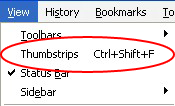
view menu option
|
what are some of the features in ThumbStrips?

the ThumbStrip menu
The purpose of ThumbStrips is to help you find what you're looking for.
To that end, all of its features were designed to be easily accessible
and intuitive to use. You can find most of them directly on the
ThumbStrip or from the ThumbStrip menu.
The various features include:
- showing time of last visit. The ThumbStrip displays the time you last saw each page, right below each thumbnail. And it's meaningful; instead of just a date and time, it tells you precisely how long ago it was.
- capturing page scroll position. As you scroll up and down a page, the page's thumbnail shows exactly what you see on the screen. And when you click a previous thumbnail, it will take you to the exact spot where you last were.
- resizability. Whether you like the thumbnails small or large, you can find a height for your needs. Simply drag the bar separating the ThumbStrip from the page, and the thumbnails will move right with you.
- smart tab behavior.
Each separate Firefox window has its own ThumbStrip, and within a
window, the window's ThumbStrip will capture thumbnails from every tab.
So you can keep using tabbed browsing to your heart's content, without fear of losing pages. You can even middle-click or Ctrl+click thumbnails to open them in a new tab.
- multiple ways to scroll. By default, you can scroll through thumbnails by simply sliding your mouse left and right along the ThumbStrip, so you can find pages faster.
If you prefer another method, you can turn mouse scrolling off from the
ThumbStrip menu under Options and use either the DVD-type controls at
the top, or the old-school scrollbar at the bottom of the window.
- starting/stopping recording. If you want to browse without taking new thumbnails, you can stop recording for as long as you want.
You can access this option not only from the ThumbStrip menu, but also
by right-clicking either the toolbar button or the status bar icon. In
addition, you can use the View menu option, or for the keyboard users,
you can press Ctrl+Shift+S or F4.
- instantaneous search.
As you type, thumbnails will disappear and appear in the blink of an
eye. And everything within every page is searched, so if you read it, you can find it. Click the Clear link to instantly show every thumbnail again.
- filtering by domain.
If you want to see thumbnails from only one or more particular sites,
you can filter the ThumbStrip by domains. The filter can be set to any combination possible;
for example, if you want to see only Wikipedia and Google pages, go to
the ThumbStrip menu and set the filter to show en.wikipedia.org,
google.com and nothing else. Turn the filter off at any time by setting
it to show all domains.
- sorting.
We often visit a page multiple times (for example, a search results
page). To handle multiple visits, the ThumbStrip condenses all the
visits into one thumbnail, and sorts different thumbnails so that the
most recently viewed thumbnails are at the end. As you browse, the
thumbnails will even resort themselves instantly, without any effort on your part. If you want to change this default behavior, you can do so from the ThumbStrip menu under Sort.
- saving and loading thumbstrips.
When bookmarking single pages isn't enough, try saving your
thumbstrips. Delete thumbnails you don't want (by right-clicking on the
thumbnail), or filter them out, and save the thumbnails for later
access. You can even save them to disk or to your DropBox account, so that you can share thumbstrips with friends and family.
This is ideal for collaborative projects, academic research,
step-by-step tutorial creation, unfinished window shopping, and more.
- drag and drop placement. Just move thumbnails around to organize the filmstrip the way you want before saving and sending.
- add comments so that you can easily take notes on a specific thumbnail. Notes that are saved, searchable, and shareable as well!
|
quick help ...
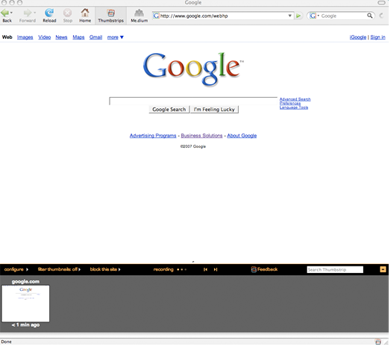
Open the ThumbStrip viewer at any time to see thumbnails of pages you have seen during this browsing session.
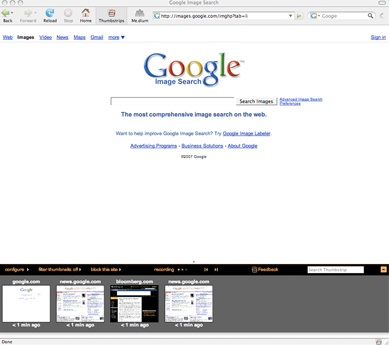
As you continue browsing, thumbnails will be added.
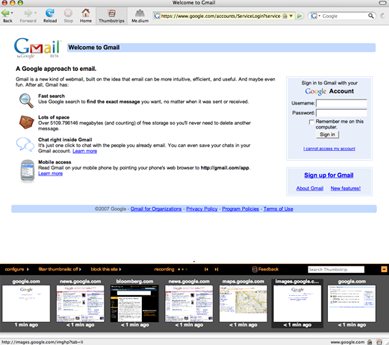
Click any thumbnail to instantly return to that page.

Prevent specific sites or domains from recording.

As you type, the ThumbStrip searches every page and instantly removes thumbnails that don't match.
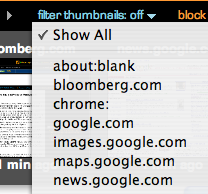
Filter by domain to show only thumbnails from certain sites.
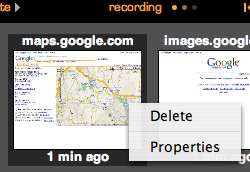
Right-click any thumbnail to delete it or to view its properties.
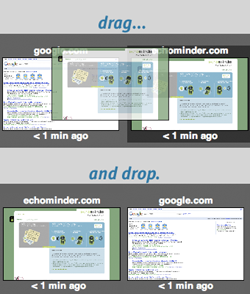
Drag and Drop thumbnails to create your own sort order.
Adding comments to thumbnails is as easy as:

One ...

Two ...

Three!
|

 Press the ThumbStrip button on the toolbar.
Press the ThumbStrip button on the toolbar. Click the ThumbStrip icon in the status bar.
Click the ThumbStrip icon in the status bar. Open the View menu, and choose ThumbStrips.
Open the View menu, and choose ThumbStrips. Press Ctrl+Shift+F or F2.
Press Ctrl+Shift+F or F2.













